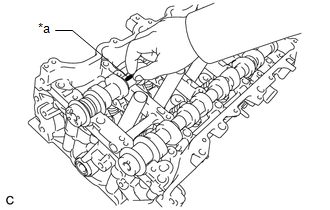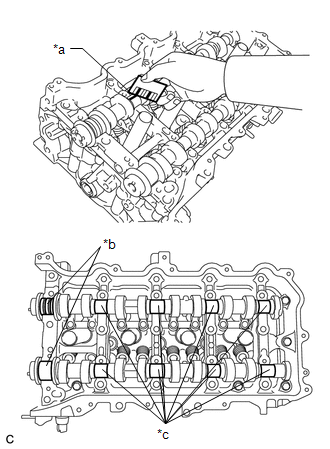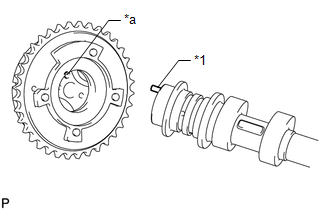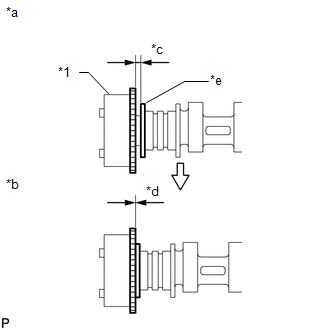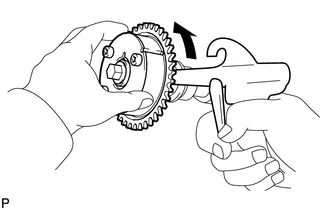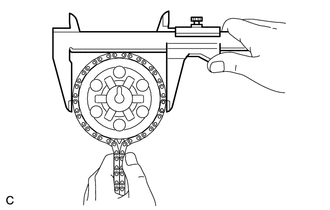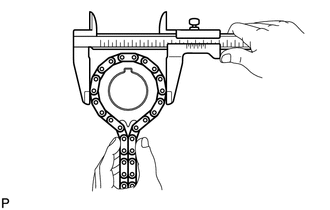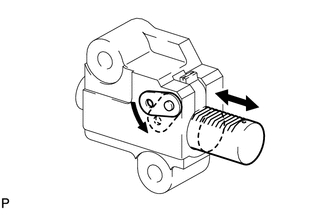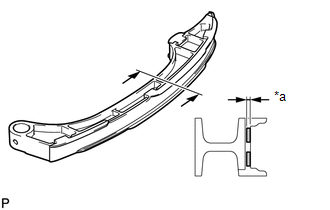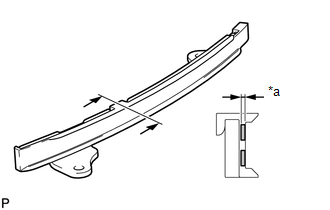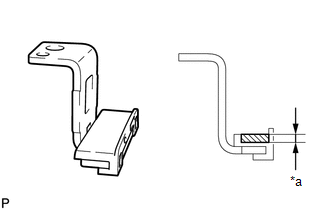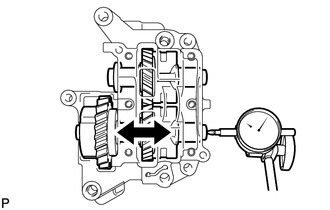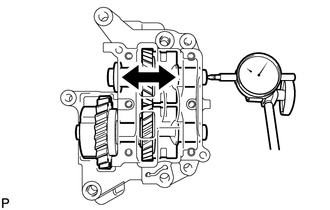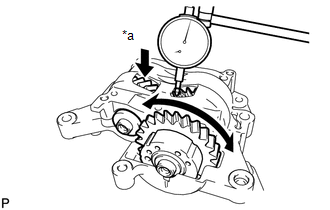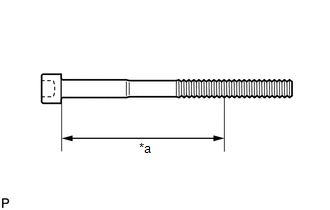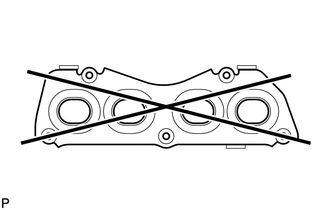Lexus NX: Inspection
INSPECTION
PROCEDURE
1. INSPECT NO. 1 VALVE ROCKER ARM SUB-ASSEMBLY
(a) Turn the roller by hand and check that it turns smoothly.
If the roller does not turn smoothly, replace the No. 1 valve rocker arm sub-assembly.
2. INSPECT VALVE LASH ADJUSTER ASSEMBLY
NOTICE:
- Keep the adjuster free from dirt and foreign matter.
- Use only clean engine oil.
(a) Place the valve lash adjuster assembly into a container full of new engine oil.
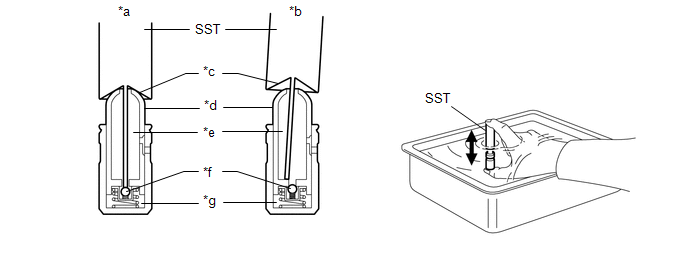
| *a | CORRECT | *b | INCORRECT |
| *c | Taper Part | *d | Plunger |
| *e | Low Pressure Chamber | *f | Check Ball |
| *g | High Pressure Chamber | - | - |
(b) Insert the tip of SST into the lash adjuster plunger and use the tip to press down on the check ball inside the plunger.
SST: 09276-75010
(c) Squeeze SST and the valve lash adjuster assembly together to move the plunger up and down 5 to 6 times.
(d) Check the movement of the plunger and bleed air.
OK:
Plunger moves up and down.
NOTICE:
When bleeding high-pressure air from the compression chamber, make sure that the tip of SST is actually pressing the check ball as shown in the illustration. If the check ball is not pressed, air will not bleed.
(e) After bleeding the air, remove SST. Then try to quickly and firmly press the plunger with your fingers.
OK:
Plunger can be pressed 3 times.
If the plunger can still be compressed after pressing it 3 times, replace the valve lash adjuster assembly with a new one.
3. INSPECT CAMSHAFT OIL CLEARANCE
NOTICE:
Do not turn the camshafts.
(a) Clean the bearing caps, camshaft housing sub-assembly and camshaft journals.
(b) Place the camshafts on the camshaft housing sub-assembly.
| (c) Lay a strip of Plastigage across each of the camshaft journals. |
|
(d) Install the camshaft bearing caps.
Click here .gif)
.gif)
(e) Install the camshaft housing sub-assembly.
Click here .gif)
.gif)
(f) Remove the camshaft bearing caps.
Click here .gif)
| (g) Measure the Plastigage at its widest point. Standard Oil Clearance:
Maximum Oil Clearance:
If the oil clearance is more than the maximum, replace the camshaft. If necessary, replace the camshaft housing sub-assembly. |
|
4. INSPECT CAMSHAFT THRUST CLEARANCE
Click here .gif)
.gif)
5. INSPECT CAMSHAFT
(a) Inspect the camshaft runout.
(1) Place the camshaft on V-blocks.
(2) Using a dial indicator, measure the circle runout at the center journal.
Maximum circle runout:
0.03 mm (0.00118 in.)
If the circle runout is more than the maximum, replace the camshaft.
HINT:
Check the oil clearance after replacing the camshaft.
(b) Inspect the cam lobes.
(1) Using a micrometer, measure the cam lobe height.
Standard Cam Lobe Height:
| Item | Specified Condition |
|---|---|
| Intake | 43.814 to 43.914 mm (1.725 to 1.729 in.) |
| Exhaust | 42.939 to 43.039 mm (1.691 to 1.694 in.) |
Minimum Cam Lobe Height:
| Item | Specified Condition |
|---|---|
| Intake | 43.704 mm (1.721 in.) |
| Exhaust | 42.829 mm (1.686 in.) |
If the cam lobe height is less than the minimum, replace the camshaft.
(c) Inspect the camshaft journals.
(1) Using a micrometer, measure the journal diameter.
Standard Journal Diameter:
| Item | Specified Condition |
|---|---|
| No. 1 journal | 34.449 to 34.465 mm (1.356 to 1.357 in.) |
| Other journals | 22.959 to 22.975 mm (0.904 to 0.905 in.) |
If the journal diameter is not as specified, check the oil clearance.
6. INSPECT CAMSHAFT TIMING GEAR ASSEMBLY
| (a) Align the knock pin of the camshaft with the knock pin hole of the camshaft timing gear assembly and attach the camshaft timing gear assembly to the camshaft. |
|
| (b) Check that there is no clearance between the camshaft timing gear assembly and camshaft flange. |
|
(c) Fix the camshaft in place by hand, and then install the bolt of the camshaft timing gear assembly by hand.
NOTICE:
Do not use any tools to install the bolt. If the bolt is installed using a tool, the lock pin will be damaged.
(d) Check the lock of the camshaft timing gear assembly.
(1) Make sure that the camshaft timing gear assembly is locked.
NOTICE:
Be careful not to damage the camshaft.
(e) Release the lock pin.
(1) Clean the camshaft journal with non-residue solvent.
(2) Cover the 4 oil paths of the cam journal with vinyl tape as shown in the illustration.
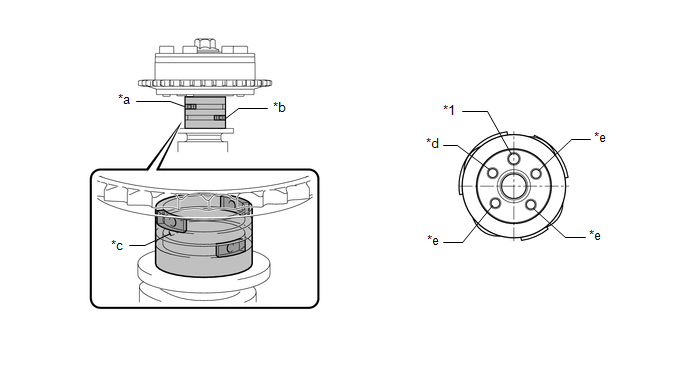
| *1 | Knock Pin | - | - |
| *a | Retard Side Path | *b | Advance Side Path |
| *c | Port A | *d | Open |
| *e | Closed | - | - |
 | Rubber |  | Vinyl Tape |
HINT:
There are 4 oil paths in the grooves of the camshaft. Plug three of the paths with pieces of rubber.
(3) Open a hole at port A shown in the illustration.
| (4) While applying compressed air at approximately 200 kPa (2.0 kgf/ cm2, 29 psi) to the oil path, forcibly turn the camshaft timing gear assembly in the advance direction (counterclockwise). CAUTION: Cover the paths with a piece of cloth when applying pressure to keep oil from splashing. NOTICE: Do not allow the camshaft timing gear assembly to lock. If it locks, release the lock pin again. HINT:
|
|
(f) Check for smooth rotation.
(1) Turn the camshaft timing gear assembly within its movable range (26.5 to 28.5°) 2 or 3 times, but do not turn it to the most retarded position. Make sure that the gear turns smoothly.
NOTICE:
Do not allow the camshaft timing gear assembly to lock.
If it locks, release the lock pin again.
(g) Remove the vinyl tape and pieces of rubber from the camshaft.
(h) Remove the bolt and camshaft timing gear assembly.
7. INSPECT CHAIN SUB-ASSEMBLY
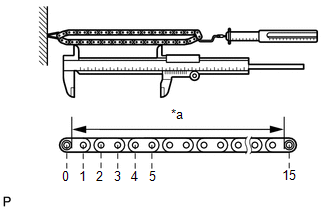
| *a | Measuring Area |
(a) Using a spring scale, pull the chain with a force of 147 N (15 kgf, 33.0 lbf) as shown in the illustration.
(b) Using a vernier caliper, measure the length of 15 pins.
Maximum chain elongation:
137.7 mm (5.42 in.)
HINT:
Perform the measurement at 3 random places.
If the elongation is more than the maximum, replace the chain sub-assembly.
8. INSPECT CAMSHAFT TIMING SPROCKET
| (a) Wrap the chain around the sprocket. |
|
(b) Using a vernier caliper, measure the sprocket diameter together with the chain.
Minimum sprocket diameter (with chain):
115.12 mm (4.53 in.)
If the diameter is less than the minimum, replace the chain sub-assembly and camshaft timing sprocket.
HINT:
The vernier caliper must contact the chain rollers for the measurement.
9. INSPECT CRANKSHAFT TIMING SPROCKET
| (a) Wrap the chain around the sprocket. |
|
(b) Using a vernier caliper, measure the sprocket diameter together with the chain.
Minimum sprocket diameter (with chain):
59.94 mm (2.36 in.)
If the diameter is less than the minimum, replace the chain sub-assembly and crankshaft timing sprocket.
HINT:
The vernier caliper must contact the chain rollers for the measurement.
10. INSPECT NO. 1 CHAIN TENSIONER ASSEMBLY
| (a) Move the stopper plate counterclockwise to release the lock. Push the plunger and check that it moves smoothly. If necessary, replace the No. 1 chain tensioner assembly. |
|
11. INSPECT CHAIN TENSIONER SLIPPER
| (a) Measure the depth of wear of the chain tensioner slipper. Maximum depth: 1.0 mm (0.0394 in.) If the depth is more than the maximum, replace the chain tensioner slipper. |
|
12. INSPECT NO. 1 CHAIN VIBRATION DAMPER
| (a) Measure the depth of wear of the No. 1 chain vibration damper. Maximum depth: 1.0 mm (0.0394 in.) If the depth is more than the maximum, replace the No. 1 chain vibration damper. |
|
13. INSPECT TIMING CHAIN GUIDE
| (a) Measure the depth of wear of the timing chain guide. Maximum depth: 1.0 mm (0.0394 in.) If the depth is more than the maximum, replace the timing chain guide. |
|
14. INSPECT NO. 1 BALANCE SHAFT THRUST CLEARANCE
| (a) Using a dial indicator, measure the thrust clearance while moving the No. 1 balance shaft back and forth. Standard thrust clearance: 0.05 to 0.09 mm (0.00197 to 0.00354 in.) Maximum thrust clearance: 0.09 mm (0.00354 in.) If the thrust clearance is more than the maximum, replace the engine balancer assembly. |
|
15. INSPECT NO. 2 BALANCE SHAFT THRUST CLEARANCE
| (a) Using a dial indicator, measure the thrust clearance while moving the No. 2 balance shaft back and forth. Standard thrust clearance: 0.05 to 0.09 mm (0.00197 to 0.00354 in.) Maximum thrust clearance: 0.09 mm (0.00354 in.) If the thrust clearance is more than the maximum, replace the engine balancer assembly. |
|
16. INSPECT BALANCE SHAFT BACKLASH
| (a) Fix the No. 2 balance shaft in place, and then, using a dial indicator, measure the backlash of the No. 1 and No. 2 balance shafts as shown in the illustration. Standard backlash: 0.04 to 0.17 mm (0.00157 to 0.00669 in.) Maximum backlash: 0.17 mm (0.00669 in.) NOTICE: Measure at 3 or more areas around the circumference of the No. 1 and No. 2 balance shafts. If the backlash is more than the maximum, replace the engine balancer assembly. |
|
17. INSPECT CYLINDER HEAD SET BOLT
| (a) Using a vernier caliper, measure the diameter of the elongated thread at the measuring point. Measuring point: 106 mm (4.17 in.) Standard diameter: 10.85 to 11.00 mm (0.427 to 0.433 in.) Minimum diameter: 10.6 mm (0.417 in.) If the diameter is less than the minimum, replace the cylinder head set bolt. HINT: If a visual check reveals no excessively thin areas, check the center of the bolt (see illustration) and find the area that has the smallest diameter. |
|
18. INSPECT EXHAUST MANIFOLD CONVERTER SUB-ASSEMBLY
| (a) Using a precision straightedge and feeler gauge, measure the warpage of the surface that contacts the cylinder head sub-assembly. Maximum warpage: 0.7 mm (0.0276 in.) If the warpage is more than the maximum, replace the exhaust manifold converter sub-assembly. |
|

